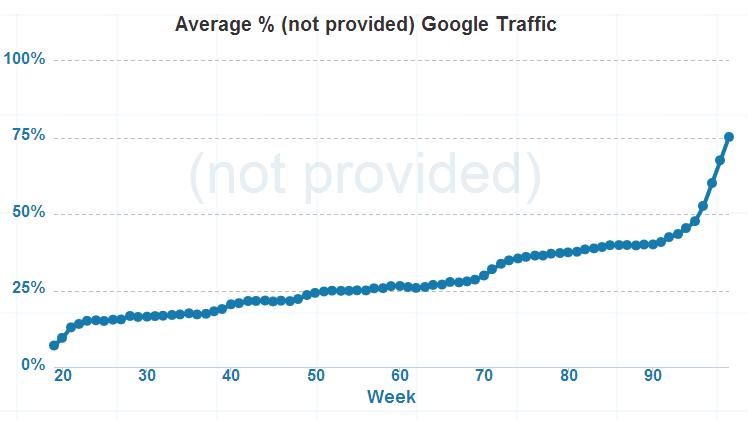In October 2011, Google started to change the level of organic search data that was delivered to webmasters. This was done by limiting any referring keywords for users who were searching on a secure server – which mainly applied to people logged-in to a Google account.
Any keyword data from these sources would from then on be reported as “Not Provided” and this obviously restricted the level of insight that webmasters could gain from their sites organic traffic.
Since then, the percentage level of “Not Provided” keywords has steadily grown as more people remain logged-in to some form of Google account (i.e. Mail, YouTube, Google+ etc.) This has become increasingly problematic for webmasters who want to gain a full picture of their sites’ performance and also for marketers who want to implement an accurate strategy for their online business.
That is until this past week, when the site Not Provided Count reported a drastic rise in the level of “Not Provided” keywords across its test platform of 60 websites.
The explanation for this has now been revealed as Google expanding its level of secure search to a much wider portion of users – including those who aren’t even signed-in to a Google account. The upshot of this is essentially Google working towards a 100% “Not Provided” situation and this is a reality that webmasters and marketers alike will have to come to terms with.
Without debating the reasoning behind Google making this move (you can find plenty of discussion around this online here, here and here), I will be looking at the main implications of this change and what effect this will have on SEO and marketing as a whole.
Back to basics?
With the lack of keyword data coming from analytics packages (not just Google Analytics), there has to be a massive shift in how we determine the success of our SEO efforts, and I believe that this will partly involve going back to our roots and relying on rank tracking.
With the introduction of personalised and localised search results, tracking keyword rankings for a site has become an increasingly difficult and unreliable task, with many marketers moving towards non-brand traffic as a source of data. However, with that well running dry in the near future, we may have to swallow our pride and try to glean the success of our efforts from ranking positions, at least in the short-term.
Focus on where traffic is going, not where it’s come from
This is something that I feel a lot of marketers neglect, however with the recent changes, it will be one of the only ways we can truly measure the success of any online campaign. We will have to start monitoring where traffic is going (i.e. landing pages), rather than where it has come from (keywords). As a general rule the majority of brand traffic for a site lands on the homepage, a fact which allows us to interpret something from an increase in traffic to a deep page.

This is why we should be making landing pages the focus of our SEO efforts, rather than specific keywords. If we can demonstrate that certain landing pages, as the core of our campaign, have seen uplifts in traffic, this is testament to our work and simply acts as a new way for us to show progress.
Use Webmaster Tools data – with a pinch of salt
Google Webmaster Tools has long provided impression and click-through data for websites, as well as some form of rank reporting, however the numbers are rounded and don’t offer the same kind of granular detail that Google Analytics does. Where it can be useful is in providing impression vs. click data over time (by query and by page) and this provides an easy-reference overview of your sites performance, however the accuracy of the data really needs to improve before it can be considered as any kind of replacement for Analytics.
Test, test, test – with PPC!
The “Not Provided” issue only applies to Google organic search, meaning that keyword data from AdWords is still fully transparent. If you aren’t doing it now (even though you should be!), using small-scale AdWords campaigns can offer great insight into keyword performance and may shape your approach to organic search. Not only can PPC tests give you information around search traffic and click-through rates, but also how valuable keywords are in terms of converting users through your site. So, if you are planning on expanding your SEO campaign and want to evaluate the potential success of a set of keywords, running these through AdWords to gain some significant results will offer an indication of how to proceed.
Take a holistic view
It’s not the answer that most people will be looking for, however taking a top-level view of your organic traffic can be as good an indication as any about your sites performance and how successful your recent campaigns have been. After all, everyone wants to see their organic traffic on the climb, all other data simply serves in allowing us to be more granular and also to diagnose any problems that arise. For a quick, snapshot view of performance, seeing an upward trend in organic traffic could be all you need to know that what youre doing is working.



